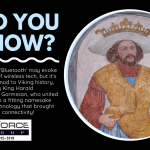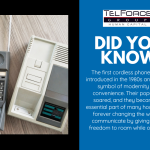Fax Machines: A Pioneering Invention That Transformed Telecom
In the fast-paced world of modern communication, where emails, instant messaging, and video calls are the norm, it’s easy to forget the humble beginnings of telecommunication. One of the cornerstones of this transformation is the fax machine. Invented by Alexander Bain in 1843, the fax machine marked a significant milestone in telecommunications history, enabling the transmission of images and written documents over long distances via telegraph lines. This remarkable invention has evolved over the years, contributing to the efficiency and convenience of businesses and individuals worldwide. In this blog post, we will delve into the fascinating history and evolution of fax machines and explore their impact on modern telecommunications.
Alexander Bain: The Birth of Fax Machines
The story of fax machines begins in the early 19th century when the Scottish inventor Alexander Bain introduced a groundbreaking invention that would revolutionize telecommunications. His invention was the precursor to the fax machines we know today.
Alexander Bain’s fax machine utilized a combination of electrical and chemical processes to transmit images and written documents over telegraph lines. The device featured a rotating cylinder with two metallic pens, one at the transmitting end and the other at the receiving end. To transmit an image or text, a document was placed on the transmitting end and an electric current was applied to the pens, causing them to replicate the content on the receiving cylinder, creating an accurate facsimile at the other end.
The use of telegraph lines allowed for the transmission of these facsimiles over long distances, opening up new possibilities for businesses, government agencies, and individuals. This was a breakthrough in the world of communication, making it possible to share information quickly and efficiently, even when physical distance separated the parties involved.
The Evolution of Fax Machines
As with many pioneering inventions, the fax machine underwent significant developments over the years. While Alexander Bain’s initial invention was groundbreaking, subsequent inventors and engineers made substantial improvements.
The Pantelegraph: Caselli’s Contribution
One of the early contributions to the evolution of fax machines was the Pantelegraph, developed by Giovanni Caselli in the mid-19th century. This device improved upon Bain’s design, introducing clockwork mechanisms for more precise synchronization between the transmitting and receiving ends. The Pantelegraph played a pivotal role in the adoption and advancement of fax technology.
The Advent of Digital Fax
The 20th century witnessed a transformation in fax technology with the transition from analog to digital systems. Digital fax machines replaced the need for physical document transmission, allowing users to scan documents and send them as digital data. This shift brought about improved quality, speed, and convenience, marking a significant turning point in the history of fax machines.
The Impact on Business and Communication
Fax machines have had a profound impact on business and communication, revolutionizing the way information is shared and received. The convenience and speed of fax technology have played a crucial role in shaping the modern business landscape.
Enhanced Efficiency
One of the key advantages of fax machines is the speed at which information can be transmitted. Businesses no longer had to rely solely on traditional mail or courier services, which could take days or weeks. Instead, they could send contracts, invoices, and important documents instantly, streamlining their operations and decision-making processes.
Global Communication
The advent of fax machines allowed for global communication on a whole new level. Companies could now interact with international partners and clients seamlessly. This was particularly significant for businesses with a global reach, as they could exchange information, sign contracts, and conduct negotiations efficiently.
Accessibility and Convenience
Fax machines made it easier for individuals to access information remotely. This was particularly beneficial for professionals who needed to work from home or when traveling. Documents could be sent and received from virtually anywhere, reducing the need to be physically present in an office.
The Fax Machine in the Modern World
While the traditional fax machine with its distinct sounds and printed paper output may have become less common, the concept of faxing has not disappeared. In the modern world, digital faxing and online fax services have taken the reins, bringing faxing into the digital age.
Digital Fax Services
Digital fax services allow users to send and receive faxes through email or dedicated online platforms. This eliminates the need for a physical fax machine, making it more cost-effective and environmentally friendly. These services provide the ability to send and receive faxes in various formats, including PDF and other common document types.
E-Signatures and Faxing
E-signatures have become a crucial component of modern faxing. With the integration of e-signature solutions, individuals and businesses can sign documents electronically, further streamlining the process of contract signing and document authentication. This innovation has accelerated the transition to a paperless, digital world.
The Legacy of the Fax Machine
The fax machine, from its inception by Alexander Bain to its digital form today, has left an indelible mark on telecommunications and modern business practices. While it may no longer occupy the center stage of communication tools, it has paved the way for subsequent innovations and continues to be used in various industries.
A Tool of Nostalgia
For some, the traditional fax machine is a source of nostalgia, reminiscent of a time when its distinctive beeping and whirring sounds were part of the daily work routine. Its legacy lives on in pop culture, where it often serves as a symbol of communication from the past.
An Architect of Progress
The fax machine’s legacy is also seen in the progress it has inspired. The concept of instant document transmission has evolved into a cornerstone of modern communication technology, shaping the way we exchange information in the digital age.
Conclusion
The fax machine, born out of Alexander Bain’s ingenious invention in 1843, represents a transformative moment in telecommunications history. Over the years, it evolved from its mechanical roots to become a digital powerhouse, providing enhanced efficiency, global connectivity, and remote accessibility. While the traditional fax machine may be fading into history, the concept of faxing lives on in digital form, contributing to the ever-evolving landscape of modern communication. Alexander Bain’s pioneering invention not only changed the way we communicate but also paved the way for further innovations that continue to shape the world of telecommunications.
Sources:
- “Alexander Bain and the First Fax” – Thought Co – https://www.thoughtco.com/history-of-the-fax-machine-1991379
- “Fax” – Wikipedia – https://en.wikipedia.org/wiki/Fax
- “When Was The Fax Machine Invented” – HP.com – https://www.hp.com/us-en/shop/tech-takes/when-was-fax-invented
- “The Evolution of Fax Technology – How to Use Phones Instead of Fax Machines” – Tech Pluto – https://www.techpluto.com/the-evolution-of-fax-technology-how-to-use-phones-instead-of-fax-machines/
- “The Impact of Fax Machines on Business Communication” – CIO Review –https://telecom.cioreview.com/vp/telecom/how_the_innovation_of_faxing_improved_business_communication/
- “10 benefits of e-signature in the modern workplace” – Ink Paper – https://www.inkpaper.ai/post/10-benefits-of-e-signature-in-the-modern-workplace
- “Fax Machines in the Digital Age: A Sustainable Choice for Businesses” – Online Geeks – https://onlinegeeks.net/fax-machines-in-the-digital-age/





